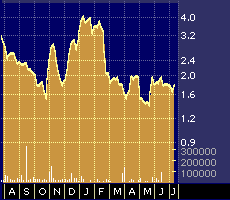
Rough Seas Seen for Health-Care B2Bs
Rough Seas Seen for Health-Care B2Bs
by Hal Plotkin
Silicon Valley Correspondent
Despite general enthusiasm about business-to-business (B2B) Internet stocks, analysts who follow health-care trends see major challenges ahead for the two health-care B2B firms that went public this week.
“They’re going up against a scarier set of players,” says Claudine Singer, health-care analyst at Jupiter Communications, based in New York. “Even if they have excellent technologies and products, the only way smaller firms are going to survive in that market is by partnering up.”
Atlanta-based Landacorp Inc. {LCOR} went public Wednesday with shares initially priced at 10, at the top of the company’s initial target range of 8 to 10. The stock moved up slightly after its debut, before very quickly giving most of those gains back.
Meanwhile, Xcare.net Inc. {XCAR}, based in Englewood, Colo., got a quicker jump out of the gate Thursday, after opening its first day of trading at 18, above its initial target range of 11 to 13.

Landacorp post-IPO stock performance

XCare.net post-IPO stock performance
Landacorp and Xcare both face similar competitive challenges even though they are focused on different parts of the health-care marketplace. Those problems include the slow pace of change in the health-care sector and substantial competition from major players with much larger footprints in the emerging online health-care industry sector, such as Careinsite Inc. {CARI}, based in Elmwood Park, N.J., and Santa Clara, Calif.-based Healtheon/WebMD Inc. {HLTH}.
“It’s advantage Healtheon at this point,” Singer says. “Really, it’s point match almost.”
Peter Boland, an industry analyst and founder of Boland Healthcare, based in Berkeley, Calif., agrees.
“At this point in the market, Healtheon is an amazing juggernaut with a full head of steam,” Boland says. “It doesn’t mean they’ll become the Microsoft {MSFT} of the health-care industry, because the market is so big and virtually untapped. But it does mean Healtheon has a very decided first-mover advantage that has huge implications in areas such as name ID and product depth. Those advantages are so large it forces others to spend far more on advertising and positioning.”
Singer says firms such as Healtheon/WebMd and its rival Careinsite, which has a longer track record serving larger numbers of health-care businesses, are able to address a wider range of business needs confronting the health-care industry. Over the long run, she says, that doesn’t leave much room for niche players focused primarily on smaller slices of the overall market.
Landacorp, for example, specializes in using the Internet to automate the process of health-care insurance authorization and verification. The company’s technology makes it easier for medical-service providers to determine which treatments are covered for which patients and reduces the time it takes for payments to be processed. The firm was created in 1980, initially focused on making software products for the health-care industry based on Microsoft’s DOS, the operating system that preceded Microsoft’s Windows.
Xcare.net has also been through several transitions since it was originally established in 1989 as Reilly Dike Dosher Corp. The company changed its name to MPower Solutions, Inc. in December 1996, and finally to Xcare.net last April.
The latest name change signifies the company’s transition from its original client-server based roots to an orientation around XML, an emerging software standard that backers say will revolutionize the way information is accessed and processed on the Internet. Client-server systems predate the Internet and are used primarily in large businesses with multiple employee workstations.
The hope is that XML will become a standard high-performance format used by all industries online, including health care, that will enable compatibility and interoperability between information-technology systems made by different vendors.
Like many other analysts who follow the field, though, Singer says health-care institutions, which are slowly but inexorably moving toward adopting Internet-based systems for internal management, accounting, and administration, probably won’t want to work with a large number of small technology providers who can only address individual parts of their overall needs.
“These companies are really coming out of the woodwork,” says Eric Brown, who leads the health-care research team at Forrester Research, based in Cambridge, Mass.
Brown says he sees a future for companies such as Landacorp and Xcare that are working to use the Internet to improve the health-care industry’s administrative practices. But, he says, that future is not here yet.
“For this year at least, the real activity in the health-care space will be on the procurement side,” Brown says.
Brown says companies mining the online procurement niche, such as Medibuy Inc., based in San Diego and Santa Clara, Calif.-based Neoforma.com Inc. {NEOF}, both of which have marketing deals with Healtheon/WebMD, are likely to do much better over the short run.
“The real low-hanging fruit are the e-marketplaces for health-care supplies and equipment,” Brownsays. “It will be some time before we see substantial infrastructure penetration into the health-care industry’s core operating environment.”
Analysts say the best hope for niche Internet B2B firms focused on the administrative or process side of the health-care industry is if they can develop best-of-breed applications that make them acquisition targets by one of the larger, more-established players.
“If you look at it, Healtheon can’t possibly create best-of-breed applications in every single health care-related field,” Singer says. “But Healtheon is very good at finding the best-in-class operations and scooping them up. That could be a very good way of being eaten.”
Boland warns, however, that investors could easily make the wrong bets if they back smaller B2B health-care firms on the hope they will eventually be acquired.
“If that is their strategy, then 98 percent of the firms will fail,” Boland says. “What these companies have to demonstrate is tangible value on cost and efficiency to customers. More importantly, they must also show they are a generation ahead in terms of technology and have a plan to stay ahead. And they must also demonstrate they have the ability to quickly and flawlessly implement their solutions. Those are all very difficult things to achieve. Most of the companies in the market aren’t even close to that yet.”
Landacorp posted a loss of $904,000 on revenue of $4.6 million for the six months ended June 30, as compared with a loss of $700,000 on revenue of $2.5 million for the same period a year earlier. The company’s top three customers are insurance firms, such as Blue Shield of California. All told, Landacorp has more than 200 paying customers.
Xcare.net posted a loss of $934,000 on revenue of $1.84 million for the six months ended June 30, as compared with a loss of $2.28 million on revenue of $1.04 million for the same period a year earlier. Just four customers, including Employers Mutual Inc., accounted for 81 percent of the company’s total sales for the six months ended June 30.
Guide to Car Insurance Websites and Auto Insurance Web Sites
Hal’s Guide to Investment Web Sites
Term Life Insurance
Webhosting


